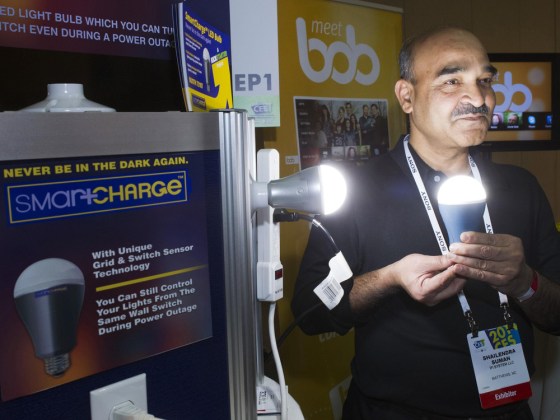We come to mourn the incandescent light bulb, banned from manufacture and import into the United States as of Jan. 1, 2014, the deadline on the Energy Independence and Security Act (EISA) signed by former President George W. Bush seven years earlier.
Some who loathe the odd design or unforgiving glare of early halogen, compact fluorescent and LED bulbs claim they'll hoard any remaining stock of 40- and 60-watt incandescent light bulbs. Others balk at ponying up $15 for an LED bulb, even if it uses 85 percent less energy.
Now, tech companies are trying to win over incandescent die-hards with a new generation of energy-efficient alternatives that do way more than just light up the room.
The top dog is Hue, from Philips, which lets you dim the lights, set different color mood lighting and wake up with light that brightens gradually. You don't even need to flip a switch — it all works through an app on your smartphone or tablet.
Cool, right? So why doesn't everyone have these things? Because a starter pack including a bridge and three light bulbs will set you back $200.
That would explain why so few of your friends have these lighting their living rooms and why other companies think they can break into the market. Here is the best of what debuted this week at the Consumer Electronics Show (CES) in Las Vegas.
WeMo Smart LED Bulbs
It costs about $5 to replace an incandescent light bulb with halogen one, so why would anyone would want to pay 12 times that amount for something that performs the same core function?
In other words, if this tech is going to go mainstream, it has to get cheaper. Belkin's new WeMo Smart LED Bulbs are a step in the right direction. Each bulb will sell for $39.99, which is $20 cheaper than Hue, and the starter kit will cost you $129 for two bulbs and a wireless hub.
Minus the ability to change colors, the WeMO Smart LED Bulb offers a lot of the same features that Hue does, plus the ability to connect with Belkin's other WeMo smart devices like its motion detectors.
Lumen Smart Bulb
If you can't beat them on price, you need to offer more features. So what light bulb is worth $70?
One that can change colors, turn on when it senses you from 50 feet away, flash when you're getting a phone call, sync color effects to your music and mimic the sunrise in the morning. All you need is a smartphone with Bluetooth 4.0 and you're ready to go — no additional hardware required. While the Lumen Smart Bulb is being premiered at CES, you can already buy one on Amazon.
SmartCharge
If you're like most Americans, blackouts involve fumbling around in the dark for a flashlight that might or might not have batteries in it.
Thankfully, North Carolina entrepreneur Shailendra K. Suman has solved that problem. The SmartCharge actually contains its own battery and, thanks to its built-in CPU, knows the difference between you hitting the "Off" switch and the grid losing power. You can get your own with a $35 donation to its ongoing Kickstarter campaign.
Holi Smart Lamp
No, you don't need this. But just imagine altering the colors of your Soho loft with your iPad as Franz from the art gallery down the street nods in approval.
The 18 LED lights are barely visible in the lamp's sleek, minimalist design. Plus, it syncs with your music for impromptu dance parties.
Style, of course, doesn't come cheap. It's expected to sell for around $200 once it's released in the United States.
Keith Wagstaff writes about technology for NBC News. He previously covered technology for TIME's Techland and wrote about politics as a staff writer at TheWeek.com. You can follow him on Twitter at @kwagstaff and reach him by email at: Keith.Wagstaff@nbcuni.com
